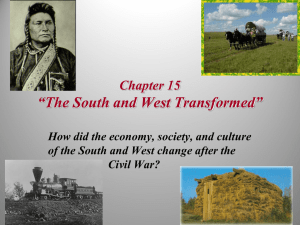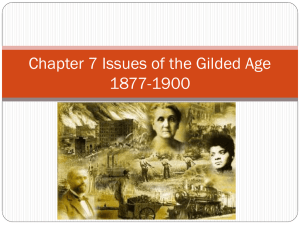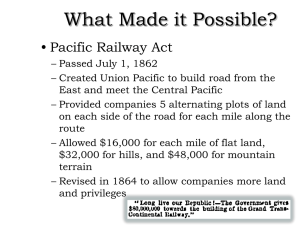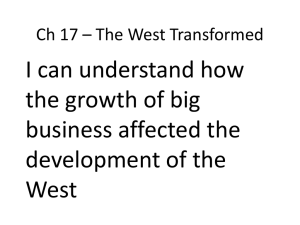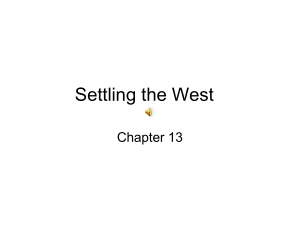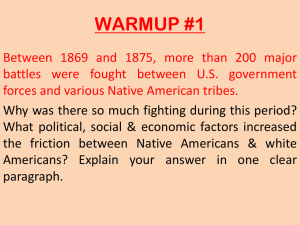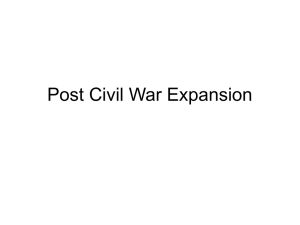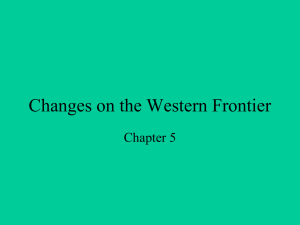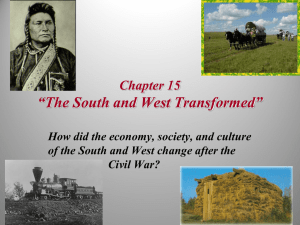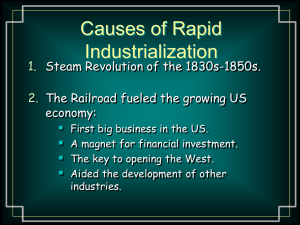Unit 4 Power Point Notes
advertisement
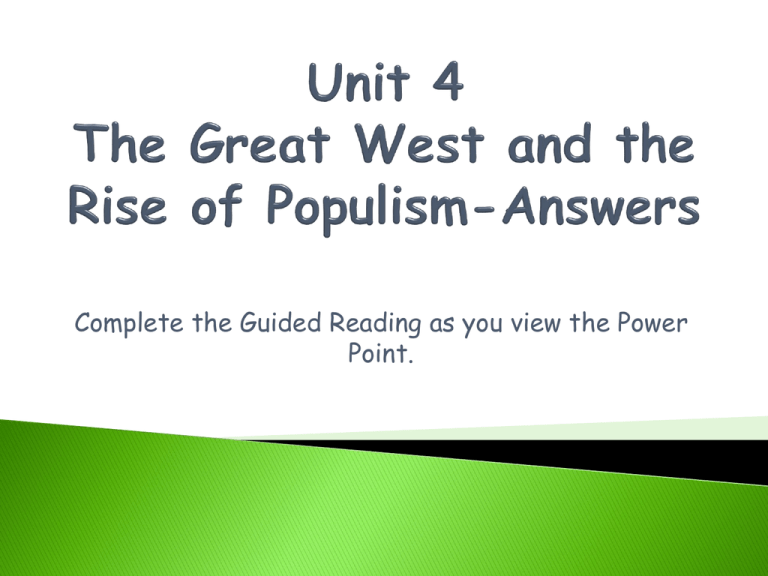
Complete the Guided Reading as you view the Power Point. Objective 4.01: Compare and contrast the different groups of people who migrated to the West and describe the problems they experienced. Essential Questions: • Who migrated West and what problems did they experience? • How did the experiences of the settlers impact their successes or failures? • Why did different groups of people have such varied experiences as they migrated? Western Migration As the nation expanded West settlers moved west to start a new life Settlers had many different reasons for moving West Many people moved West to spread the Christian message to Native Americans Mormons moved West from Illinois to escape religious persecution Mormons: religious group founded by Joseph Smith 1830- Joseph Smith wrote a book called The Book of Mormon- he claimed it was a translation of writings given to him by an angel It became the foundation of the Mormon faith The group was made fun of because of the beliefs in The Book of Mormon ◦ Polygamy- having many wives ◦ Gave Joseph Smith too much power over the people of the religion ◦ Smith was believed to be a prophet 1844 a mob of people killed Joseph Smith and forced the group to move out West for safety A man named Brigham Young led them out of Illinois to Utah where they settled Many people moved West to get rich The California Gold Rush of 1849 brought thousands of people to the territory in search of riches So many people moved to California that it needed an organized government and it was added as a state to the Union Comstock Load: A man named Comstock found the richest load of minerals ever discovered 1859 the Comstock Lode was discovered in western Nevada People rushed to Nevada to find gold Why is it important? ◦ Gold eventually became one of the major reasons for conflict New territory meant that more people had the opportunity to own land 1862 Congress passed two laws that encouraged people to settle out West ◦ Homestead Act ◦ Morrill Land-Grant Act Homestead Act: Anyone who agreed to farm 160 acres of land for five years would receive the title to that land from the federal government People on the prairies lived in sod houses made out of thick prairie grass and mud Sod House Morrill Land-Grant Act: distributed millions of acres of western territory to state governments ◦ States then sold the land to pay for agriculture “land grant” colleges Taught farmers how to use new technology and deal with the unfamiliar terrain of the Midwest Why is it important? ◦ Homestead Act and Morrill Land-Grant Acts greatly increased the number of western settlers in the years following the Civil war As more people moves out West they began to ask the government to open Indian Lands for white settlement 1889 central Oklahoma was declared open 50,000 people gathered at the Oklahoma border waiting for a gun to sound the start of the race for land In the Oklahoma Land Rush people raced on foot, horses, wagons, bicycles, etc. to stake a claim to a piece of land Sooners: people who cheated and got a head start to get their land “sooner” Oklahoma is known as the Sooner State Oklahoma Land Rush 1889 http://www.youtube.com/watch?v=yxaJY 8UZxn4 Women had more freedom out West than they had in the East Life was so rough in the West that everyone had to do what they could to survive The frontier required a more flexible society Women often had the opportunity to take on roles traditionally only open to men Chinese and Irish immigrants moved West and played major roles in the development of the railroads African Americans served as cowhands on western ranches A large number of cowboys in the 1800’s were African Americans who moved out West after the Civil War and the abolition of slavery Many African Americans served as soldiers in the United States Army One group of distinguished African American soldiers were the Buffalo Soldiers They were members of four all black regiments that were known for their bravery in battle Buffalo Soldiers Objective 4.02: Evaluate the impact that settlement in the West had upon different groups of people and upon the environment. Essential Questions: • How did the environment of the West impact the success of the settlers? • How did the migration of people bring about change in the West? • What cause individuals or groups to migrate? • Was the impact of settlement in the West positive or negative? • How do individuals adapt to their surroundings? Conflicts with Native Americans increased when more and more white people moved out West Native Americans (the Plains Indians) depended on buffalo for food, clothing and shelter to survive Settlers and trappers moved West and killed the buffalo for their fur and to make room for ranchers to bring cattle out West Why is it important? ◦ By 1889 only 1,000 buffalo were left in America and the Plains Indians could no longer continue their way of life Buffalo Hunt Buffalo Kill The cattle industry affected the Plains Indians Mexican culture and language had a great impact on how white settlers lived in the southwest Mexican ranchers influenced white settlers in Texas- they taught them how to ranch ◦ How to herd, raise and drive cattle to market Why is it important? ◦ White settlers began to imitate Mexican dress and culture Cowboys hats and chaps The Cattle Industry and Mining Industry Transformed the West: The growth of the cattle industry contributed to the slaughter of buffalo ◦ Buffalo would have been in competition as a food source against cattle The cattle industry also took land from the Native Americans Cowtowns: Towns to which ranchers would drive their cattle so that they could be herded onto trains and shipped East to market Cowboys: People who moved cattle on long drives to cowtowns The Mining Industry transformed the West as people relocated to find their fortune Mining camps and mining towns developed as people moved West Eventually, huge companies moved West with advanced equipment to dig for metals The Mining Industry hurt the Native Americans as they were forced to move off of their land and relocate to reservations Reservations: Sections of land where the federal government forced Native Americans to relocate Cowboy Life Native Americans were forced to move to a new location each time gold was discovered Why is it important? Over time many native Americans became angry and many wars broke out Large numbers of Native Americans eventually died as a result of being forced to travel long distances and settle on reservations in lands where they were not accustomed to living Important Battles Between U.S. Troops and Native Americans Many times Native Americans chose to resist moving off their land and being relocated to reservations 1861 the U.S. government forced the Cheyenne Native Americans to give up land that had been promised to them As payback Chief Black Kettle led Cheyenne warriors in several raids on mining camps and local settlements The U.S. responded by surprising 500 Cheyenne at Sand Creek- killed 270 Native Americans- most were women and children Why is it important? ◦ It led to Little Bighorn When news of Sand Creek spread other Native American tribes became very angry Chief Red Cloud and Chief Crazy Horse led the Sioux Indians in an up-rising 1876 U.S. commander George Custer tried to defeat the Sioux at the battle of Little Bighorn Custer underestimated the size of the native American forces and rushed into battle Why is it Important? ◦ Custer and 200 men died ◦ Was the last great victory of the Native Americans ◦ By 1877 the Sioux and the Cheyenne had surrendered to the U.S. and were moved to reservations in the Dakotas and Oklahoma Crazy Horse Monument, South Dakota Chief Joseph led the Native American tribe called the Nez Perce Violence broke out when the U.S. government tried to remove the Nez Perce from the Oregon Territory Nez Perce warriors attacked white settlers without Chief Joseph’s approval Chief Joseph told his people to follow U.S. orders to move to a northern reservation to avoid more bloodshed As they moved to the new reservation federal troops attacked the Nez Perce in retaliation for their attack on settlers Why is it important? ◦ ◦ ◦ ◦ Chief Joseph told his people to retreat and try to escape to Canada They were stopped 30 miles from the Canadian border They were forced to move to reservations in Oklahoma The Nez Perce almost died out due to sickness and malnutrition A Sioux holy man developed a religious ritual called the Ghost Dance The Sioux believed this would bring back the buffalo and return Native American tribes to their land The Ghost Dance scared white settlers The U.S. government sent in the Army to control the situation The government believed the Sioux leader Sitting Bull was using the Ghost Dance to start a Native American uprising Why is it important? ◦ When soldiers tried to arrest Sitting Bull a gunfight broke out and 14 people died including Sitting Bull ◦ The soldiers then followed the Sioux to Wounded Knee Creek ◦ When the battle was over more than 150 Native Americans were dead Many were unarmed women and children Sioux Leader Sitting Bull Sioux Warrior Sitting Bull Sitting Bull and Crazy Horse at the Battle of Little Bighorn The Aftermath of Little Bighorn Battle of Little Bighorn Battle at Wounded Knee The Gold Rush and Native Americans Settlers and Native Americans 1881 Helen Hunt Jackson wrote a book called A Century of Dishonor The book described the shameful way the Native American people had been treated Why is it important? The book helped create concern for native American rights and laws to protect them Dawes Act 1887 law that was meant to help Native Americans blend into American culture ◦ Abolished tribal organizations and divided up reservations to give land to individual Native American families ◦ After 25 years Native Americans would be able to own the land and become U.S. citizens Why is it important? ◦ Law was a failure ◦ Native Americans didn’t want to lose their tribal identity or blend into white culture ◦ The land they were promised was sometimes not good for farming ◦ Many Native Americans were cheated by government officials ◦ The Native American population continued to die from poverty and disease Objective 4.03: Describe the causes and effects of the financial difficulties that plagued the American farmer and trace the rise and decline of Populism. Essential Questions: • How and why was the plight of the American farmer so different from that of other Americans? • Why did so many farmers support Populism? • How can economically oppressed groups make their voices heard politically? Objective 4.04: Describe innovations in agricultural technology and business practices and assess their impact on the West. Essential Questions: • How can technological innovations change society? • Why did the agricultural innovations and technological developments impact groups of people in different ways? • How did the existence of the frontier impact the technological development of the U.S.? Railroads, Farming and the Rise of Populism In the late 1800’s railroads became an important means of transportation in the United States Congress coordinated with the railroad companies to build a transcontinental railroad across the United States From the East the Union Pacific Railroad would join with the Central Pacific Railroad from the West 1869: The two railroads joined in Utah Many Irish and Chinese immigrants worked on the railroad Union and Pacific Railroad Routes Joining of Union Pacific and Central Pacific Railroads in Utah- (gold spike) Farming Out West For settlers to move West and survive they needed suitable land for farming Many technological advances made it possible for settlers to survive in the West ◦ John Deere’s Steel Plow: allowed farmers to plow hard ground ◦ Windmills: allowed farmers to capture wind power and pump water to the surface of the ground ◦ Barbed Wire: allowed farmers to fence their land and livestock ◦ Railroads: allowed farmers to get equipment they needed from the East and ship their products around the country ◦ Why is it important? People could farm out West without being isolated from the rest of the nation Farmers had many problems in the late 1800’s Overproduction of farm products made prices drop and led to less profits At the same time cost of farm equipment and railroad rates rose Farmers lost money and fell into debt Many people joined together to stand up to the railroads for overcharging Local farmers formed groups called granges to pool their resources and buy new machinery, supplies sell their products without paying other distributors Concerns of the farmers led to a rise in the Populist Movement in the late 1800’s Farmers wanted the government to use greenbacks (paper money) to increase the nation’s money supply Farmers wanted a “free silver” policy They wanted to base the U.S. dollar value on silver as well as gold Why is it important? ◦ Farmers thought greenbacks and free silver would put more money into the nation’s economy and help farmers in debt Farmers who supported populism wanted more government regulation of business ◦ Especially railroads and warehouses This put populists against big business who favored laissez-faire economics (the belief in no government interference in business) Populists wanted government to regulate the prices that railroads could charge farmers to haul their products and machinery Populists wanted the government to pay rebates (subsidies) to farmers whose goods did not sell due to over production Many state legislatures passed laws limiting how much railroads and storage houses could charge Why is it important? ◦ The Supreme Court ruled in Munn v. Illinois that states had the right to regulate certain businesses within its borders ◦ The Supreme Court ruled in Wabash v. Illinois that railroad traffic that crossed state lines was to be regulated by the federal government, not states ◦ 1887 President Cleveland signed the Interstate Commerce Act: created an Interstate Commerce Commission and regulated railroad rates in the best interest of the public Populism appealed to the “common man” Populism saw agriculture as the backbone of America Populism favored the working class (working people) of the Northeast and the farmers of the South and West 1892 Populists met in Nebraska and wrote the Omaha Platform Omaha Platform: called for the use of silver, government regulation of railroads, and industry, a graduated income tax, and election reform 1896 the U.S. was in an economic depression People blamed President Cleveland and his decision to repeal the Sherman Silver Purchase 1893 Sherman Silver Purchase allowed for the use of the silver standard (a position supported by the Populists where paper money value is based on silver as well as gold) President believed the silver standard was the cause of the nation’s economic depression, so he returned the nation to the gold standard Why is it important? ◦ The silver question became the major issue of the 1896 campaign The Democratic Party of 1896 was divided at the convention The Democrats nominated William Jennings Bryan to run for president The Populists supported Bryan because he supported bimetallism (a silver and gold standard) At the Democratic Convention Bryan made a famous speech called “Cross of Gold” “You shall not press down upon the brow of labor this crown of thorns, you shall not crucify mankind upon a cross of gold!” Why is it important? The split in the Democratic party hurt Bryan and he lost the election of 1896 to Republican William McKinley McKinley was supported by the big business of the Northeast and states with large electoral votes McKinley’s win marked the end of the Populist Party’s influence in politics Many Populist ideas were adopted by the Progressive Party in the 1900’s and led to many reforms in the U.S. government
